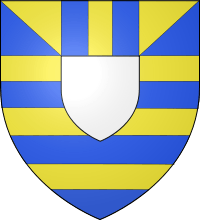Roger Mortimer, 1st Baron Mortimer

Roger Mortimer, 1st Baron Mortimer, of Wigmore (1231 – 30 October 1282), was a famous and honoured knight from Wigmore Castle in Herefordshire. He was a loyal ally of King Henry III of England. He was at times an enemy, at times an ally, of Llywelyn ap Gruffudd, Prince of Wales.
Early career
Born in 1231, Roger was the son of Ralph de Mortimer and his Welsh wife, Princess Gwladys Ddu, daughter of Llywelyn ab Iorwerth and Joan Plantagenet, daughter of John "Lackland", King of England.
In 1256 Roger went to war with Llywelyn ap Gruffudd when the latter invaded his lordship of Gwrtheyrnion or Rhayader. This war would continue intermittently until the deaths of both Roger and Llywelyn in 1282. They were both grandsons of Llywelyn ab Iorwerth.
Mortimer fought for the King against the rebel Simon de Montfort, 6th Earl of Leicester, and almost lost his life in 1264 at the Battle of Lewes fighting Montfort's men. In 1265 Mortimer's wife, Maud de Braose helped rescue Prince Edward; and Mortimer and the Prince made an alliance against de Montfort.
Victor at Evesham
In August 1265, de Montfort's army was surrounded by the River Avon on three sides, and Prince Edward's army on the fourth. Mortimer had sent his men to block the only possible escape route, at the Bengeworth bridge. The Battle of Evesham began in earnest. A storm roared above the battle field. Montfort's Welsh soldiers broke and ran for the bridge, where they were slaughtered by Mortimer's men. Mortimer himself killed Hugh Despencer and Montfort, and crushed Montfort's army. Mortimer was awarded Montfort's severed head and other parts of his anatomy, which he sent home to Wigmore Castle as a gift for his wife, Lady Mortimer.
Welsh wars and death
Mortimer took part in Edward I's 1282 campaign against Llewelyn the Last, and was put in charge of operations in mid-Wales.[1] It was a major setback for Edward when Mortimer died in October 1282.[1]
Marriage and children
Lady Mortimer was Maud de Braose, daughter of William de Braose, Lord of Abergavenny by Eva Marshal. Roger Mortimer had married her in 1247. She was, like him, a scion of a Welsh Marches family. Their six known children were:[2]
- Ralph Mortimer, died 10 August 1274, Sheriff of Shropshire and Staffordshire.
- Edmund Mortimer, 2nd Baron Mortimer (1251–1304), married Margaret de Fiennes, the daughter of William II de Fiennes and Blanche de Brienne. Had issue, including Roger Mortimer, 1st Earl of March
- Isabella Mortimer, died 1292. She married (1) John Fitzalan, 7th Earl of Arundel,[2] (2) Ralph d'Arderne and (3) Robert de Hastang;[3]
- Margaret Mortimer, died 1297. She married Robert de Vere, 6th Earl of Oxford
- Roger Mortimer, 1st Baron Mortimer of Chirk, died 1326.
- Geoffrey Mortimer, died 1273.
- William Mortimer, died before June 1297, a knight, married Hawise, daughter and heir of Robert de Mucegros. Died childless.
Their eldest son, Ralph, was a famed knight but died in his youth. The second son, Edmund, was recalled from Oxford University and appointed his father's heir.
Epitaph
Roger Mortimer died on 30 October 1282, and was buried at Wigmore Abbey, where his tombstone read:
- Here lies buried, glittering with praise, Roger the pure, Roger Mortimer the second, called Lord of Wigmore by those who held him dear. While he lived all Wales feared his power, and given as a gift to him all Wales remained his. It knew his campaigns, he subjected it to torment.
Ancestry
| Ancestors of Roger Mortimer, 1st Baron Mortimer | ||||||||||||||||||||||||||||||||||||||||||||||||||||||||||||||||||||||||||||||||||||||||||||||||||||||||||||||||||||||||||||||||||||||||||||||||||||||||||||||||||||||||||||||||||||||||||||||||||||||||||||||||||||||||||||||||||||||||||||||||||||||||||||||||||||||||||||||||||||||||||||||||||||||||||||||||||||||||||||||||||||||||||||||||||||||||||||||||||||||||||||||||||||||||||||||||||||||||||||||||||||||||||||||||||||||||||||||||||||||||||||||||||||||||||||||||||||||||||||||||||||||||||||||||||||||||||||||||||
|---|---|---|---|---|---|---|---|---|---|---|---|---|---|---|---|---|---|---|---|---|---|---|---|---|---|---|---|---|---|---|---|---|---|---|---|---|---|---|---|---|---|---|---|---|---|---|---|---|---|---|---|---|---|---|---|---|---|---|---|---|---|---|---|---|---|---|---|---|---|---|---|---|---|---|---|---|---|---|---|---|---|---|---|---|---|---|---|---|---|---|---|---|---|---|---|---|---|---|---|---|---|---|---|---|---|---|---|---|---|---|---|---|---|---|---|---|---|---|---|---|---|---|---|---|---|---|---|---|---|---|---|---|---|---|---|---|---|---|---|---|---|---|---|---|---|---|---|---|---|---|---|---|---|---|---|---|---|---|---|---|---|---|---|---|---|---|---|---|---|---|---|---|---|---|---|---|---|---|---|---|---|---|---|---|---|---|---|---|---|---|---|---|---|---|---|---|---|---|---|---|---|---|---|---|---|---|---|---|---|---|---|---|---|---|---|---|---|---|---|---|---|---|---|---|---|---|---|---|---|---|---|---|---|---|---|---|---|---|---|---|---|---|---|---|---|---|---|---|---|---|---|---|---|---|---|---|---|---|---|---|---|---|---|---|---|---|---|---|---|---|---|---|---|---|---|---|---|---|---|---|---|---|---|---|---|---|---|---|---|---|---|---|---|---|---|---|---|---|---|---|---|---|---|---|---|---|---|---|---|---|---|---|---|---|---|---|---|---|---|---|---|---|---|---|---|---|---|---|---|---|---|---|---|---|---|---|---|---|---|---|---|---|---|---|---|---|---|---|---|---|---|---|---|---|---|---|---|---|---|---|---|---|---|---|---|---|---|---|---|---|---|---|---|---|---|---|---|---|---|---|---|---|---|---|---|---|---|---|---|---|---|---|---|---|---|---|---|---|---|---|---|---|---|---|---|---|---|---|---|---|---|---|---|---|---|---|---|---|---|---|---|---|---|---|---|---|---|---|---|---|---|---|---|---|---|---|---|---|---|---|---|---|---|---|---|---|---|---|---|---|---|---|---|---|---|---|---|---|---|---|---|---|---|---|---|---|---|---|---|---|---|---|---|---|---|---|---|---|---|---|---|---|---|---|---|---|---|---|---|---|---|---|---|---|---|---|---|---|---|---|---|---|---|---|---|---|---|---|---|---|---|---|---|---|
| ||||||||||||||||||||||||||||||||||||||||||||||||||||||||||||||||||||||||||||||||||||||||||||||||||||||||||||||||||||||||||||||||||||||||||||||||||||||||||||||||||||||||||||||||||||||||||||||||||||||||||||||||||||||||||||||||||||||||||||||||||||||||||||||||||||||||||||||||||||||||||||||||||||||||||||||||||||||||||||||||||||||||||||||||||||||||||||||||||||||||||||||||||||||||||||||||||||||||||||||||||||||||||||||||||||||||||||||||||||||||||||||||||||||||||||||||||||||||||||||||||||||||||||||||||||||||||||||||||
Notes
- 1 2 Prestwich, Michael (2007). Plantagenet England: 1225–1360 (new ed.). Oxford: Oxford University Press. p. 154. ISBN 0-19-822844-9.
- 1 2 J. J. Crump, ‘Mortimer, Roger (III) de, lord of Wigmore (1231–1282)’, Oxford Dictionary of National Biography, Oxford University Press, 2004.
- ↑ The Complete Peerage, 2000, vol.IX, p.281
Sources
- Mortimer, Ian. The Greatest Traitor: The Life of Sir Roger Mortimer, 1st Earl of March, Ruler of England 1327-1330, Jonathan Cape, London, 2003. ISBN 0-224-06249-2
- Remfry, P.M., Wigmore Castle Tourist Guide and the Family of Mortimer (ISBN 1-899376-76-3)
- Remfry, P.M., Brampton Bryan Castle, 1066 to 1646 (ISBN 1-899376-33-X)
- Dugdale, Sir William The Baronage of England, Vol. 1, 1661.
| Peerage of England | ||
|---|---|---|
| Preceded by (new creation) |
Baron Mortimer | Succeeded by Edmund Mortimer |